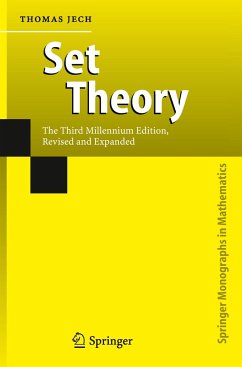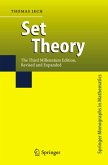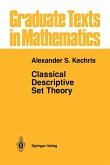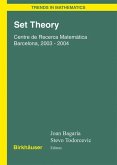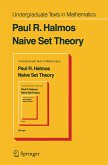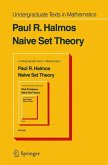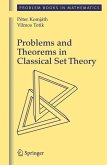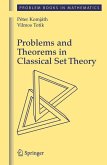Set Theory has experienced a rapid development in recent years, with major advances in forcing, inner models, large cardinals and descriptive set theory. The present book covers each of these areas, giving the reader an understanding of the ideas involved. It can be used for introductory students and is broad and deep enough to bring the reader near the boundaries of current research. Students and researchers in the field will find the book invaluable both as a study material and as a desktop reference.
From the reviews of the third edition:
"Thomas Jech's text has long been considered a classic survey of the state of the set theory ... . As every logician will know, this is a work of extraordinary scholarship, essential for any graduate logician who needs to know where the current boundaries of research are situated. Each chapter ends with a valuable historical survey and there is an extensive bibliography. This will continue to be the bible for set theorists in the new century." (Gerry Leversha, The Mathematical Gazette, March, 2005)
"The book does masterly what it is supposed to do. ... every mathematician who wishes to refresh his knowledge of set theory will read it with pleasure. ... They will also find historical notes, and precise references ... . A very comprehensive bibliography, and detailed indexes complete the work. This book fills a serious gap in the literature and there is no doubt that it will become a standard reference ... . One can strongly recommend its acquisition for any mathematical library." (Jean-Roger Roisin, Bulletin of the Belgian Mathematical Society, Vol. 11 (3), 2004)
"One of the classical textbooks and reference books in set theory is Jech's Set Theory. ... The present 'Third Millennium' edition ... is a whole new book. In three parts the author offers us what in his view every young set theorist should learn and master. ... This well-written book promises to influence the next generation of set theorists, much as its predecessor has done over the last quarter of a century." (Eva Coplakova, Mathematical Reviews, 2004 g)
"Jech's book, 'Set Theory' has been a standard reference for over 25 years. This 'Third Millennium Edition', not only includes all the materials in the first two editions, but also covers recent developments of set theory during the last 25 years. We believe that this new version will become a standard reference on set theory for the next few years."(Guohua Wu, New Zealand Mathematical Society Newsletter, April, 2004)
"Jech's classic monograph has been a standard reference for a generation of set theorists. Though ... labeled 'The Third Millennium Edition', the present work is in fact a new book. ... Even sections presenting older results have been rewritten and modernized. Exercises have been moved to the end of each section. The bibliography, the section on notation, and the index have been considerably expanded as well. This new edition will certainly become a standard reference on set theory for years to come." (Jörg D. Brendle, Zentralblatt MATH, Vol. 1007, 2003)
"Thomas Jech's Set Theory contains the most comprehensive treatment of the subject in any one volume. The present third edition is a revised and expanded version ... . The third edition has three parts. The first, Jech says, every student of set theory should learn, the second every set theorist should master and the third consists of various results reflecting 'the state of the art of set theory at the turn of the new millennium'. This last part especially contains a lot of new material." (Martin Bunder, The Australian Mathematical Society Gazette, Vol. 30 (2), 2003)
"Thomas Jech's text has long been considered a classic survey of the state of the set theory ... . As every logician will know, this is a work of extraordinary scholarship, essential for any graduate logician who needs to know where the current boundaries of research are situated. Each chapter ends with a valuable historical survey and there is an extensive bibliography. This will continue to be the bible for set theorists in the new century." (Gerry Leversha, The Mathematical Gazette, March, 2005)
"The book does masterly what it is supposed to do. ... every mathematician who wishes to refresh his knowledge of set theory will read it with pleasure. ... They will also find historical notes, and precise references ... . A very comprehensive bibliography, and detailed indexes complete the work. This book fills a serious gap in the literature and there is no doubt that it will become a standard reference ... . One can strongly recommend its acquisition for any mathematical library." (Jean-Roger Roisin, Bulletin of the Belgian Mathematical Society, Vol. 11 (3), 2004)
"One of the classical textbooks and reference books in set theory is Jech's Set Theory. ... The present 'Third Millennium' edition ... is a whole new book. In three parts the author offers us what in his view every young set theorist should learn and master. ... This well-written book promises to influence the next generation of set theorists, much as its predecessor has done over the last quarter of a century." (Eva Coplakova, Mathematical Reviews, 2004 g)
"Jech's book, 'Set Theory' has been a standard reference for over 25 years. This 'Third Millennium Edition', not only includes all the materials in the first two editions, but also covers recent developments of set theory during the last 25 years. We believe that this new version will become a standard reference on set theory for the next few years."(Guohua Wu, New Zealand Mathematical Society Newsletter, April, 2004)
"Jech's classic monograph has been a standard reference for a generation of set theorists. Though ... labeled 'The Third Millennium Edition', the present work is in fact a new book. ... Even sections presenting older results have been rewritten and modernized. Exercises have been moved to the end of each section. The bibliography, the section on notation, and the index have been considerably expanded as well. This new edition will certainly become a standard reference on set theory for years to come." (Jörg D. Brendle, Zentralblatt MATH, Vol. 1007, 2003)
"Thomas Jech's Set Theory contains the most comprehensive treatment of the subject in any one volume. The present third edition is a revised and expanded version ... . The third edition has three parts. The first, Jech says, every student of set theory should learn, the second every set theorist should master and the third consists of various results reflecting 'the state of the art of set theory at the turn of the new millennium'. This last part especially contains a lot of new material." (Martin Bunder, The Australian Mathematical Society Gazette, Vol. 30 (2), 2003)

